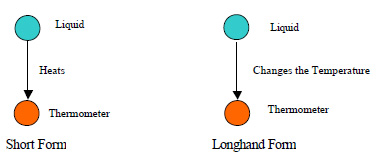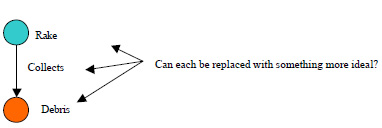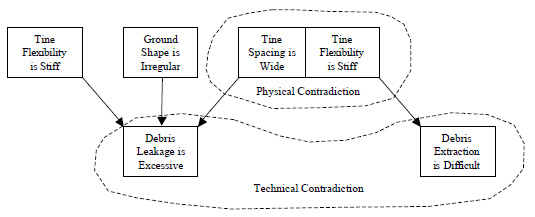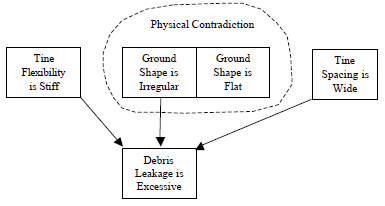Supplement to Breakthrough Thinking with TRIZ 2nd Edition
Editor | On 20, Jan 2004
Breakthrough Thinking with TRIZ provides step-by-step instructions on how to improve technical systems. It reads like a pictorial recipe book, starting on the upper left of each page and ending at the lower right. Viewing this book in electronic format is difficult. Readers who download electronic versions are encouraged to print the material and place it into a binder. The main sections are marked for tabbing. Each section (and hence each tab) corresponds to one of the ten steps shown on the front of the binder. Printed versions come with printed tabs which require insertion.
 Breakthrough Thinking with TRIZ is available for free download for personal study. Those seeking to use the material for commercial uses are requested to order the printed copies. Those seeking to translate this material into other languages are encouraged to contact the author. Requests for the original PowerPointÃ’ presentation will be considered.
Breakthrough Thinking with TRIZ is available for free download for personal study. Those seeking to use the material for commercial uses are requested to order the printed copies. Those seeking to translate this material into other languages are encouraged to contact the author. Requests for the original PowerPointÃ’ presentation will be considered.
While the author’s company has given him permission to publish TRIZ articles, this permission does not imply endorsement of any of the author’s publications. The first edition of this book was printed in the March 2002 edition of the TRIZ-Journal. Much has changed in the first edition. Following are key discussion points that explain the logic behind Breakthrough Thinking with TRIZ.
Format Goals the format for presentation has been guided by the following goals:
Adjustability The solution process should be taught at a variety of levels to suit the  capability and interest of the student. The top ten steps are always taught, but sub-steps are simplified or eliminated and then added as the student gains greater mastery. This method of teaching is widely used to teach many subjects from music to mathematics. The focus should be on gradually increasing the ability of students while allowing success during the learning process. Steps surrounded by boxes and printed in red imply that the step is for beginners and that the following steps can be skipped. Note that there are only a few such boxes and there is some distance between them.
capability and interest of the student. The top ten steps are always taught, but sub-steps are simplified or eliminated and then added as the student gains greater mastery. This method of teaching is widely used to teach many subjects from music to mathematics. The focus should be on gradually increasing the ability of students while allowing success during the learning process. Steps surrounded by boxes and printed in red imply that the step is for beginners and that the following steps can be skipped. Note that there are only a few such boxes and there is some distance between them.
Simple Nomenclature As with many disciplines, the nomenclature of TRIZ is often difficult to learn. One goal is to make the nomenclature fit ideas that the student is already familiar with. For instance, “Dynamism†is changed to “Make Adjustable†and “Local Quality†is changed to “Non-uniform.†A certain amount of new nomenclature is unavoidable, and care should be taken to introduce it at higher levels of the class so as not to confuse or intimidate beginning students.
Smaller Steps Most beginning students are baffled by the seemingly “obvious†target- solutions presented in TRIZ literature. Many of these solutions are only obvious after the fact and represent large jumps in intuition. Some teachers may feel that these large jumps are a testament to the power of TRIZ and will try to impress the student with them. Unfortunately, many students are discouraged that such solutions are not as obvious to them. One goal of this solution-process is to decrease the step size, so that solutions are the result of several smaller steps rather than a few major leaps. Another goal is to help the student see that there are many common and simple examples around them of the use of TRIZ tools.
Visualization Along with the concept of “smaller steps†is the idea that solutions need to be visualized in order to become reality. Each step should aid the practitioner in visualizing a final solution. Some may feel that elegance or compactness is sacrificed by expanding classical TRIZ steps, but the goal is to make the solution more easily visualized.
Completeness of Solution The term “solution†means different things to different people. For the sake of this solution-process, a solution is a sketch that someone could work from to design hardware. No difficult contradictions or problems would remain to be solved. Simply pointing out a physical phenomenon that might be used to solve a problem would not, in this context, be considered a solution, since difficult challenges would inevitably remain
A Hierarchy of Change is proposed, which suggests that when creating or making changes to a system, certain decisions must unavoidably precede others. A change at any level affects all levels that follow. If change were to begin at any step other than the first, assumptions must be consciously or unconsciously made. If such a hierarchy exists, then all change processes can be viewed as a management of this hierarchy. Consider the following figure depicting the proposed Hierarchy of Change for a useful function.

Sequencing of TRIZ Tools Classical TRIZ tool-sets grossly overlap each other making it difficult to know when tools are appropriate to use. The material presented in Breakthrough Thinking is the result of reassembling the classical toolsets into steps that follow the Hierarchy of Change. Care was taken to sequence the steps to ensure that in order to perform a given step, the output of previous steps would be required. For example, in order to resolve a contradiction, certain key pieces of information would be developed in previous steps. Another advantage of regrouping TRIZ tools in this fashion is that patterns emerge which were not visible before. These patterns allow for the further development of TRIZ tools.
 Solution Branches Each decision point in this linear sequence of tools follows the Hierarchy of Change. As a result, the solution process follows natural decision points, which branch to multiple solutions.
Solution Branches Each decision point in this linear sequence of tools follows the Hierarchy of Change. As a result, the solution process follows natural decision points, which branch to multiple solutions.
The figure to the right shows the branching of the solution paths at each decision point for a Useful Function. (Branching is slightly different for Harmful and Informing functions). Each step allows for multiple decisions, with each decision forming a new solution path. As shown by the diagram to the right, dozens of solutions are possible. These solutions should be evaluated on the basis of ideality, business needs and customer needs.
Functional Nomenclature It is recognized that the proliferation of TRIZ terms is objectionable and makes it difficult for the new student to translate between different authors. Sometimes different terms are used to mean the same thing. In order for the reader to “translate†while reading Breakthrough Thinking with TRI Z, a consistent nomenclature will be established. It is hoped that this nomenclature will already be familiar to most readers. A System is a collection of physical objects that deliver a function. The physical element that is acted on will be referred to as the Product. (In other texts, it may be referred to as the object or artifact). The object that acts on the Product is referred to as the Tool. What the tool does to the product will be referred to as the Modification. (In some texts, this is referred to as the action). It is usually a verb. The use of the term “Modification†will be new to many readers, however it is used to stress the requirement that the action verb must describe a change or control of an attribute of the product. This is sometimes difficult for students to grasp. Students are encouraged, in the beginning, to use a longhand form of the modification.

The longhand form begins with “Changes†or “Controlsâ€. For example, we can describe the action that occurs between a tool “liquid†and a product “thermometer†which is immersed in the liquid. The short form of the modification is “ heats†or “cools.†The longhand form of the modification would be “Changes the temperature.â€
The use of the term “modification†helps the student to understand that the tool and product must be physical elements. It also helps the student to correctly describe “confusing functions,†such as how paint protects wood. New students often say Short Form Heats Thermometer Longhand Form Changes the Temperature Thermometer Liquid Liquid Contradiction Resolution Method “Paint—protects—woodâ€. While the word “Protects†is a verb, it is not a modification, as it does not describe a change or controlling of the wood. Insistence on using the word “Protects†will hamper the problem solver in later steps. The longhand form immediately encourages the student to correctly write “Paint—controls the location of —moisture†and “wood—controls the position of —paint.†The short version now becomes “ paint — stops– moisture†and “wood—holds—paintâ€. Once the longhand form is firmly entrenched, the student can usually revert back to the short form of the modification for brevity. The modification to the product is delivered by an Effect. The term “Effect†is an artificial convention, introduced by TRIZ practitioners that allows us to group physical phenomenon into recognizable groupings. An example of an Effect would be “capillary action.†The Effect of capillary action actually arises from complex physical interactions involving several different fields at the atomic level. However, most people readily recall the phenomenon of capillary action from demonstrations of liquids rising in tubes. TRIZ literature contains tables of these Effects that are very useful. A Field, as described in TRIZ literature, is another artificial grouping convention, which allows us to talk about different manifestations of fundamental fields as recognizable groups such as vibration, electromagnetic radiation, gravity, mechanical stress and pressure. Some of these “fields†such as Odor & Taste may seem a little offbeat. One or several objects and their associated fields deliver effects. In summary, the Tool delivers the Effect, which delivers the Modification to the Product.
The Ideal Final Result, as shown here, may seem unfamiliar, since it is described in functional terms. This is done by looking at each part of the function in question (product, modification, Effect/Tool ) and asking, “Can I replace this with something more ideal?â€

The Ideal Final Result is a restructuring and reinterpretation of the parts of the “Standard Solutions†that deal with eliminating, redefining or replacing function parts (object resources). When combined with the classical concept of the Ideal Final Result, this part of the change process becomes more powerful. This is the opportunity to greatly reduce the system penalties by decreasing the number of elements and allowing elements take on more functions. The focus of this step depends upon whether we are considering Useful, Harmful or Informing (measuring or detecting) Functions. For Useful Functions, the initial focus is on the modification of the product. For Harmful Functions, the initial focus is on the tool and modification. For Informing Functions, the initial focus is on the tool. Considering the Ideal Final Result from the viewpoint of functions broadens the concept of the Ideal Final Result Beyond this step, it is assumed that the main system elements will be preserved.
The Table of Controlling Variables is a restructuring and reinterpretation of the parts of the “Standard Solutions†which deal with object knobs (knob resources). In its original form the “Standard Solutions†presented solution models with the conflict already removed. In the Table of Controlling Variables, the removal of the contradiction is delayed until the “Remove Contradiction†step, thus allowing for a greater number of ways to resolve the contradiction than those included in the “Standard Solutionsâ€. Using the Table of Controlling Variables will help the problem solver uncover several unanticipated ways to control the function.
Contradictions Classical TRIZ considers three types of contradictions, Administrative, Technical and Physical. The Administrative Contradiction states that there is a problem with an unknown solution. The Technical Contradiction states that as something improves, something else gets worse. The Physical Contradiction states that an object attribute or property must have two very different or conflicting values. Most TRIZ practitioners completely ignore the Administrative Contradiction due to its lack of tangible meaning. Many ignore the Technical Contradiction in favor of the Physical Contradiction. Classical ARIZ asserts that the Physical Contradiction is formed after first illuminating the Technical Contradiction. This thinking is not correct and has created difficulties in moving the theory of TRIZ forward.
In classical TRIZ either type of contradiction is formed after first considering an improvement to our system. Let us consider the situation of a common garden rake. When the rake is used to collect loose debris such as rocks and loose weeds over an uneven surface, a problem arises: The rake “leaks†some of the debris that is to be collected under the tines and several strokes are required to fully collect the debris. The dependent variable that we want to improve is “Debris Leakageâ€. Let us now ask, “what is the debris leakage a function of?†(For the sake of discussion, only three of the many possible knobs are shown). Debris Leakage = f (Tine Flexibility, Ground Stiffness, Tine Spacing, . . .)

Now, let us improve the situation by turning one of the knobs: Tine Flexibility. (We show this by creating another box with the conflicting knob setting). Flexible tines follow the contour of the earth and collect much more effectively. Unfortunately, other things get worse. It is more difficult to extract embedded debris from the soil and to move soil around (other functions of the rake). This difficulty can by represented by the following diagram. (For the sake of simplicity we will only consider debris extraction).

Both the Physical and Technical Contradictions show up in this diagram. The complete contradiction can now be stated: “The rake tines need to be flexible in order to collect and they need to be rigid in order to extract embedded debris from the groundâ€. The Technical Contradiction is stated “as collecting improves, extracting becomes worseâ€. The Physical Contradiction is stated, “the tines need to be stiff and flexibleâ€.
Note that the Technical Contradiction could be deduced only after identifying tine Flexibility as an independent variable. In other words, it does not always follow that as “Debris Leakage improves, Debris Extraction becomes worseâ€. Different Technical Contradictions arise if we choose different knobs to turn. Had we chosen to decrease Tine Space, we would have found that the rake now collects too much useful small debris (mu lch) that would ordinarily be left behind. Now the Technical Contradiction is different: “while improving Debris Leakage, Collection of Mulch becomes worseâ€. The Technical Contradiction is dependent on which knob we choose to turn.

A properly stated contradiction may not include a well-stated Technical Contradiction. Suppose that we had chosen the ground shape as the knob to turn. In this case it would be clumsy and artificial to identify something that gets worse if we make the ground flat. Instead it is better to conclude that the ground shape comes in many different “flavors†other than flat. The full contradiction can be stated, “in order to improve Debris Leakage, the Ground Shape needs to be flat, but since the ground shape comes in many different forms, it needs to be Irregularâ€. The Physical Contradiction can still be stated, “the Ground Shape is Flat and Irregularâ€. Many contradictions arise because a knob only comes in one “flavorâ€. While this fact does not stop us from resolving the contradiction, it does serve to show that it is not always practical to state something else that becomes worse.

A second example of a contradiction, which does not include a well-stated Technical Contradiction, occurs when we try to turn an “outcome knob†without consideration for the inputs. In other words, we want to improve something without regard for the independent variables or knobs that cause the problem. The full contradiction can be stated “the Debris Leakage must be excessive because the ground is irregular, the tine spacing is wide and the ground is irregularly shaped. The Debris Leakage must be minimal because that is what we want to improveâ€. The Physical Contradiction is stated, “ the Debris Leakage is excessive and minimalâ€

Note that while the Technical Contradiction may be difficult to state due to the foregoing reasons, the Physical Contradiction is almost always possible to state and becomes the focus for resolving the conflict. One is better off with knowledge of the fully formed contradiction. Solving the Technical Contradiction, without knowledge of the Physical Contradiction does not increase the ability of the problem solver to directly visualize the solution. One only knows that “something†must be merged, made non-uniform, etc. Solving the Physical Contradiction without knowledge of what improves and what gets worse (the Technical Contradiction) makes it difficult to know how far the knobs must be turned to create an enduring and practical solution. Both the Technical Contradiction and the Physical Contradiction are important parts of a fully stated Contradiction. For this reason, the terms Technical and Physical will be dropped and the conflict will simply be referred to as â€the Contradictionâ€.
Focusing on the Contradiction and the Table of Contradictions rather than the Technical Contradiction and the Contradiction Matrix is encouraged to enhance visualization of the solution. (For example, if an object must be both sharp and blunt, applying the Table of Contradictions enhances mental images of the solution). The Table of Contradictions provides a large number of methods for resolving contradictions. A process is presented for rapidly narrowing down possible solution methods.
References
A number of books were consulted for the writing of Breakthrough Thinking with TRIZ. The author is indebted to the following
works and their authors.
· Simplified TRIZ, Kalevi Rantanen, Ellen Domb, St. Lucie Press 2002
· The Innovation Algorithm, Genrich Altshuller, Technical Innovation Center, Inc. 1999
· Creativity as an Exact Science, G. Altshuller, Gordon and Breach, 1985.
· 40 Principles: TRIZ Keys to Technical Innovation, G. S. Altshuller, Translated by Lev Shulyak, Technical Innovation Center, 1997
· Systematic Innovation, John Terninko, Alla Zusman, Boris Zlotin, St. Lucie Press, 1998
· And Suddenly the Inventor Appeared, G. Altshuller, Technical Innovation Center, 1994
· TRIZ: The Right Solution at the Right Time, Yuri Salamatov, 1999
· The Science of Innovation, Victor R. Fey, Eugene I. Rivin, TRIZ Group, 1997
· Invention Machine Software (DOS Version to 1998 Tech Optimizer™)
Larry K. Ball
Larry.Ball@Honeywell.com
480-592-5919
Ó 2004, Larry K. Ball, all rights reserved.

